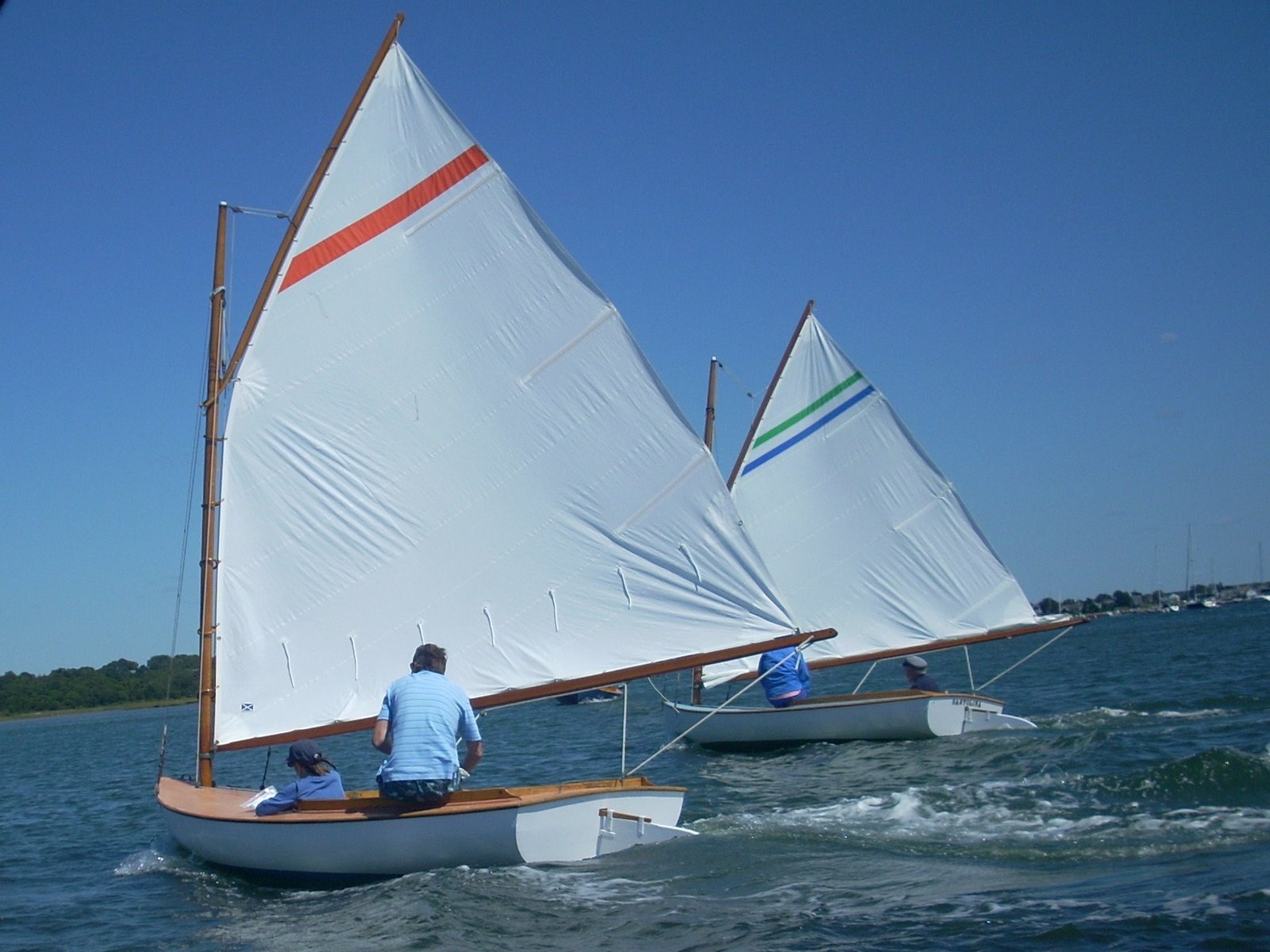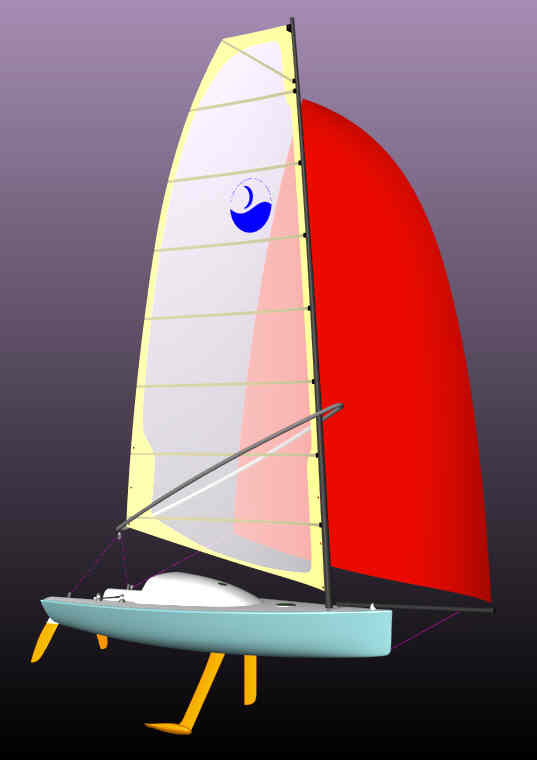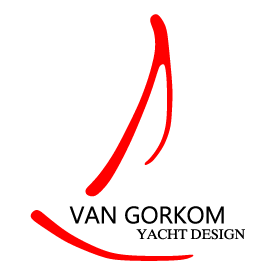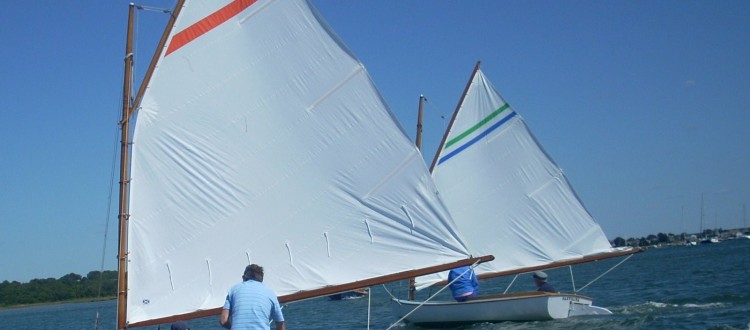Just the Ticket…Less Strings and Things

With the outstanding success of our free-standing cat rig Open30, “OverProof,” in demonstrating its offshore capabilities, Piet Human of Moondance Yachts in Cape Town, South Africa asked me “how do we give this boat a broader appeal by making it easier to handle so that it doesn’t require youth and athleticism to have it perform to its full potential?”
Coincidently, I was talking with a potential client about a similar boat for the San Francisco Bay area. He mentioned the growing following of the Wylie Cat 30 and how well the boat performed as a one-design and under the PHRF handicap system. After several discussions with Tom Wylie I soon came to realize that this might be the answer to Piet’s question. By combining a free-standing cat rig with a modern, light-weight racing hull form and state-of-the-art appendages, you could have simplicity and performance all wrapped up into one awesome package.
The history of the cat-rigged sailboat, or “cat-boat” as they came to be known, dates back as far as 1840 when they were used for fishing and coastal transportation in and around the New England area. They were characterized by a single mast carried well forward, the virtues of this type of rig being simplicity and ease of handling. Around the turn of the 19th century, catboats were adapted for racing, where long booms, gaffs, bowsprits and large jibs were fitted to capture as much wind as possible. One of the more well-know catboats of that era is the 12 foot (3.7m) Beetle Cat, which are still being built today. Some of the more contemporary cat-rigged boats include the Wyliecat 30 and 48, the Freedom 40s and smattering of one-off racing and cruising boats.
So what exactly are the advantages of a cat rig with a free-standing mast? Modern free-standing rigs are inherently safer, far less complicated, cost effective, more aerodynamically efficient, and when paired with the right platform are able to match the performance of a conventionally rigged boat.
Safer
Conventionally stayed rigs are held up by hundreds of little parts, any one of which could fail or slip resulting in a failure that could bring down the mast. A free-standing mast is held up by just two parts, the partners and the heel fitting – so the safety of the rig increases by the ratio of hundreds to 2. Failure in these areas is very unlikely if properly engineered, and can be easily inspected unlike a rigging connection at the top of a mast.
Less Complicated
The uni-sail has three trimming controls: the sheet, which is mounted at the very after end of the wish-bone boom and is controlled by winches port and starboard; a conventional cunningham arrangement lead back to the cockpit; and the choker which is a purchase system on the front of the boom that controls foot and leech tension, as well as mast bend. This serves to flatten and depower the sail in stronger wind conditions (not unlike a windsurfer rig). The uni-sail can be flown in breezes up to 25 knots without being reefed because the unstayed mast bends off in its upper sections with increasing wind pressure causing it to automatically unload. If it becomes necessary to reef, the sail has a conventional slab-reef system that is contained within lazy jacks supported by the wish-bone boom – so it becomes a one-man operation to lower and contain the sail. Because everything is so simple, there’s a lot less work to do so you don’t have to be a star athlete to sail the boat solo or double-handed. Yet, you can still maintain a very high level of performance. It also makes for far less stress when taking the family out for a Sunday cruise.
Cost Effective
The cat rigged Open30 has two sails……maybe three if you want a couple of spinnaker variations. So the cost of your sail inventory is cut dramatically, and with fewer strings to pull the deck hardware package is greatly simplified. While the mast will require more material to maintain the desired stiffness and bending characteristics, the heavier spar sections will be offset by not having spreaders, rigging terminals, standing rigging or chainplates. The wishbone boom is made from aluminum tubing and far less expensive than a conventional boom.
Aerodynamically Efficient

Free-standing rigs are more aerodynamically efficient because without wires, there is less windage (parasitic drag). In addition, the sail plan is no longer confined by the triangular shape defined by the fore and aft rigging. Because of induced drag the triangle is absolutely the worst possible planform for a lifting surface. Induced drag is a bi-product of lift, and although there are ways to manipulate it, it can never be totally eliminated. A working aerofoil, such as a wing, sail or keel, has a high pressure to windward and a low pressure to leeward and these are trying to equalize. In a triangular planform, the fluid flow on the high pressure side gets a chance to equalize sooner, by virtue of the shape (as opposed to a rectangular planform) by skewing up toward the tip and off the surface. This skewing of flow from the high pressure side, mixing with the flow on the low pressure side, creates a tip vortex. The bigger the skew, the bigger the vortex, and the greater the induced drag. A way to reduce induced drag and increase the aerodynamic efficiency of the rig is to have either an elliptical or rectangular planform as there is little tendency for the flow to twist off into a large vortex with these shapes. This is one of the main reasons for highly roached and square-topped mainsails on modern race boats. However, many of them place a great amount of importance on their running backstay systems to keep the rig up. Not so on a free-standing mast.
Comparable Performance
Cat-rigged boats have been stigmatized with a reputation for poor windward sailing capabilities and that was certainly the case with earlier designs. However, modern carbon fiber cat rigs are strong, light, aerodynamically efficient, and are able to carry a comparable amount of up-wind sail area to a conventional sloop. Between the incredible advancements in sail technology and not having a backstay to worry about, the roach of the sail can be fairly generous with full length battens to support it, creating a highly efficient airfoil. Couple this with modern sailboat design philosophies, and the result is a vessel every bit as capable of hanging with the fleet on a beat to the windward mark. The off-the-wind performance of the cat rig is just as impressive and maybe more so. The area of the unisail alone, which can be adjusted to an extremely full shape, is more than enough for a great downwind ride, and very easily handled. To complement and enhance the reaching performance, the spar on the Open30 has been engineered to allow for a fractional asymmetric spinnaker to be flown from a deck-mounted, retractable bowsprit that can be articulated 35 degrees to port or starboard.
See our cat-rigged Open30 and the Paradox 1050 for more details on these exciting new designs.
References & Credits:
- Eric Sponberg, “Some Thoughts on the State of the Art”
- Tom Wylie, “Sailing in the Right Direction”

